Summary of The Guerrilla Girls
In 1985, a group of vigilantes wearing gorilla masks took to the streets. Armed with wheat paste and posters, the Guerrilla Girls, as they called themselves, set out to shame the art world for its underrepresentation of women artists. Their posters, in the words of one critic "were rude; they named names and they printed statistics. They embarrassed people. In other words, they worked." In addition to posters (now highly-valued works of art), billboards, performances, protests, lectures, installations, and limited-edition prints make up the Guerrilla Girls' varied oeuvre. Their unorthodox tactics were instrumental in making progress. The group is still going strong, reminding the art world that it still has a long way to go. Referring to themselves as "the conscience of the art world," wherever discrimination lurks, the Guerrilla Girls are likely to strike again.
As their reputation has grown, they have encompassed targets beyond the art sphere, like Hollywood, right wing politicians, and same-sex marriage. They have collaborated with institutions that once shunned them, including the Tate Modern and MoMA, and yet their tactics remain as radical as ever. In a 2012 interview they revealed, "We've been working on a weapon, an estrogen bomb...If you drop it, the men will drop their guns and start hugging each other. They'll say, 'Why don't we clean this place up?' In the end, we encourage people to send their extra estrogen pills to Karl Rove; he needs a little more estrogen."
Accomplishments
- The Guerrilla Girls' marketing tactics were more sophisticated than that of any previous feminist campaign. Imitating advertising, and appealing to the eye of the educated mass consumer, they engaged a much broader audience.
- Gorilla masks are funny. Coopting this and other elements of humor into their communicative strategy helped dispel the notion that feminists have no sense of humor.
- The Guerrilla Girls made feminism seem like a glamorous club one could join. As New York Times art critic Roberta Smith has written, they took "feminist theory, gave it a populist twist and some Madison Avenue pizazz and set it loose in the streets." In admitting women only, and exclusively by invitation, the group mirrored power circles in the male-dominated art world.
- While adopting masks and pseudonyms like Frida Kahlo, Gertrude Stein, and Käthe Kollwitz heightened the theatricality of their public appearances, it also served a practical purpose. It afforded anonymity for working artists who had every reason to believe the institutions would launch counter attacks on their professional reputations.
- Their decision to remain anonymous is pointedly connected to the history of women in art. In the 1980s, many art history courses did not include a single woman artist, and many of the women artists whose works are now well known were relatively undiscovered.
Important Art by The Guerrilla Girls
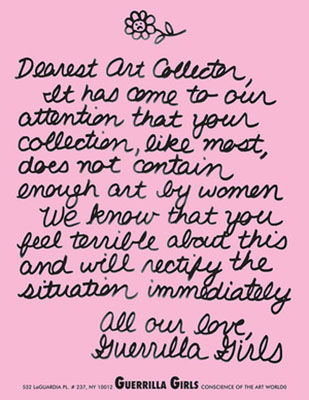
Dearest Art Collector
Shortly after forming their group, The Guerrilla Girls sent this poster to well- known art collectors, pointing out how few works they owned by women artists. Addressed "Dearest Collector", and made to resemble a hand-written letter on powder-pink paper, the rounded cursive script crowned with a frowning flower oozes femininity, exemplifying the scathing sarcasm for which the Guerrilla Girls were known. This send up of femininity is aimed at the expectation that, even when presenting a serious complaint, women should do so in a socially acceptable 'nice' way. "We know that you feel terrible about this" appeals to the feelings of the recipient. The group later transcribed it into other languages and sent it to collectors outside the U.S. A practical joke with serious implications, this poster is now (somewhat ironically) a collector's item.
Poster - Collection of the Tate, United Kingdom

The Advantages of Being a Woman Artist
The so-called "advantages" on this list numbers thirteen (i.e. an unlucky number) ways in which women are systematically excluded from art textbooks, exhibitions, and literature. "Seeing your ideas live on in the work of others" alludes to women's innovations that have been misattributed to men. "Knowing your career might pick up after you're eighty" refers to Louise Nevelson, Lee Krasner, Barbara Hepworth, and countless other women artists whose contributions to the history of art were only acknowledged at the very end of their careers. "Having the opportunity to choose between career and motherhood" addresses the persistent social expectation that women must choose (for men, there was no equivalent expectation). The list ends with a self-referential flourish: "Getting your picture in the art magazines wearing a gorilla suit." The Guerrilla Girls, working artists, were finding that they got more attention when dressed as gorillas, an irony that did not escape them. As they put it, "we discovered that the art world takes feminists more seriously when they use humor and wear a gorilla disguise." A prime example of the Guerrilla Girls' early work, this poster, distributed widely in Manhattan in 1988, uses wit and sarcasm to expose inequities of the art world.
Poster - Collection of the Tate, United Kingdom
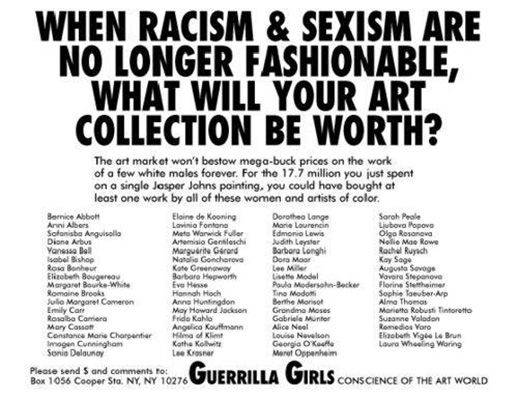
When Racism & Sexism Are No Longer Fashionable, What Will Your Art Collection Be Worth?
At the end of the 1980s, contemporary art prices rose to astronomical heights. Work by contemporary women artists, however, did not rise to reflect this spike in the market. This poster reminds art collectors that the "art market won't bestow mega-buck prices on the work of a few white males forever," and that with the 17.7 million one Jasper Johns painting was worth in the present, the collector could buy at least one work by all of the sixty-seven women artists and artists of color on this list, which would presumably be worth much more in the future. The list includes well-known women artists, both contemporary and historical, such as Diane Arbus, Mary Cassatt, Sonia Delauney, Georgia O'Keeffe, Dorothea Lange, Angelica Kauffmann, and Rosa Bonheur. Women artists of color are also included, such as Frida Kahlo, Tina Modotti, Remedios Varos, and Edmonia Lewis. Indeed, if the collector had listened, and acted as directed here, he or she would now be a billionaire.
This poster returns to a point raised three years earlier in the pink letter written to collectors. Instead of appealing to feelings, however, it makes a financially viable argument. By pointing out that one work by Jasper Johns was valued more highly than the work of all these women artists and artists of color put together, the Guerrilla Girls highlight the absurdity of the art world's sexist system of valuation. They also make the point that in order to remain competitive as an investor, a collector not only should, but must diversity his (or her) "art portfolio", by buying work by women and artists of color.
Poster - Collection of the Tate, United Kingdom
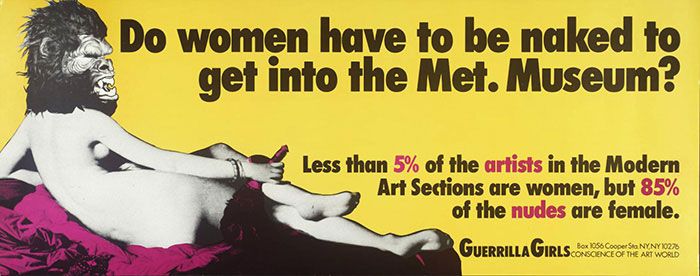
Do women have to be naked to get Into the Met.Musem?
Until 1989 there was no imagery in the Guerrilla Girls' work, just text. Then "One Sunday morning we conducted a 'weenie count' at the Metropolitan Museum of Art comparing the number of nude males to nude females in the artworks on display," they recalled. Originally designed as a billboard for the New York Public Art Fund (PAF), it transposes a gorilla head onto one of the most famous nudes in art (Jean-August-Dominique Ingres's La Grande Odalisque), transforming this refined symbol of feminine sensuality into a hybrid monster that seems to roar out the title question. On the side of a bus, where one expects to see announcements for upcoming exhibitions, "Do women have to be naked to get into the Met. Museum?" was an image intended to embarrass one of the art world's most hallowed institutions. PAF rejected the poster. The Guerrilla Girls took the project forward on their own, renting advertising space on New York City buses "until the bus company canceled our lease, saying that the image, based on Ingres's famous Odalisque, was too suggestive and that the figure appeared to have more than a fan in her hand." Hard to imagine that the bus company was really that prudish. More likely it just seemed unwise to take aim at a major institution like the Met. Since its creation, the poster has been reissued in 2012 with a recount of the representation of women artists in the Metropolitan, and repurposed in the Guerrilla Girls poster Do women have to be naked to get into music videos? (2014). With its bold type face reminiscent of advertising, and use of humor and statistics, it is the iconic Guerrilla Girls' work.
Poster - Collection of the Tate, United Kingdom
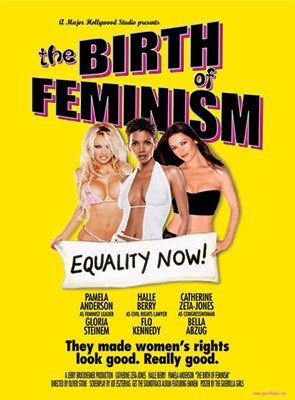
The Birth of Feminism
In the early 2000s, the Guerrilla Girls turned their focus to Hollywood's unfair treatment of the sexes, both on screen and in person. Describing the genesis of this poster, they remark: "Hollywood producers have come to us saying, 'we wanna make a movie about feminism, do you have any ideas?' And we always thought that was so ludicrous because don't we just know the kind of movie Hollywood would make? So we decided we would do the movie poster for the film that we hope never gets made the Hollywood way." Appearing to advertise for "A Major Hollywood Studio" production on American feminism, this poster features sex symbols Pamela Anderson, Halle Berry, and Catherine Zeta Jones in the starring roles of feminist leaders Gloria Steinem, Florence Kennedy, and congresswoman Bella Abzug. The beach-towel-like banner they are holding over their groins bears the title of the international women's rights organization, Equality Now, founded in 1992. Clashing with this feminist declaration is the film's title "The Birth of Feminism" (an allusion to the classic racist film The Birth of a Nation (1915)) and the words "They made women's rights look good. Really good", underscoring the superficial standards of the film industry, where women actors are, almost without exception, hired for looks as opposed to talent. Smaller text at the bottom credits Oliver Stone, Eminem, and Jerry Bruckheimer (all of whom had been criticized for perpetuating gender stereotypes) as the writers and producers of the film and soundtrack. It highlights both how unlikely the making of a blockbuster film on feminism would be, and how misrepresented the story would be if it were made into a movie.
Poster - Dallas Museum of Art, Texas
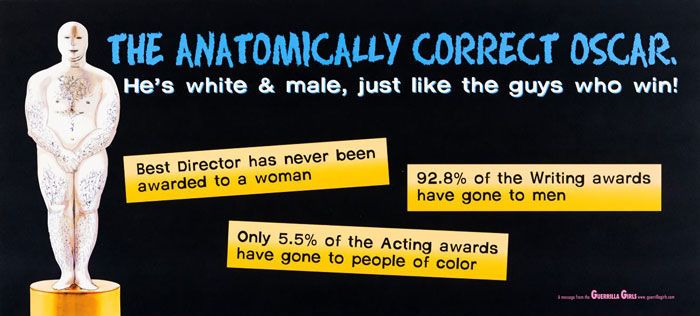
The Anatomically Correct Oscar
By the early-21st century, they had begun to critique sexism outside the visual art world. They conducted their own research on filmmaking, and featured those statistics in posters that call attention to the exclusionary practices of the film industry. A reflection of the film industry's real priorities, The Anatomically Correct Oscar is a white man hiding his genitals and standing next to text boxes that reveal the persistent gender gap in directing, acting, and screen writing. For months leading up to the Oscars in 2002, the Guerrilla Girls displayed this billboard in Hollywood because, as "Kollwitz" noted "the people we want to reach will see it... There is so much positive press around the Oscars - the gowns, the stars - that we decided it was time for another point of view."
Poster - Dallas Museum of Art, Texas
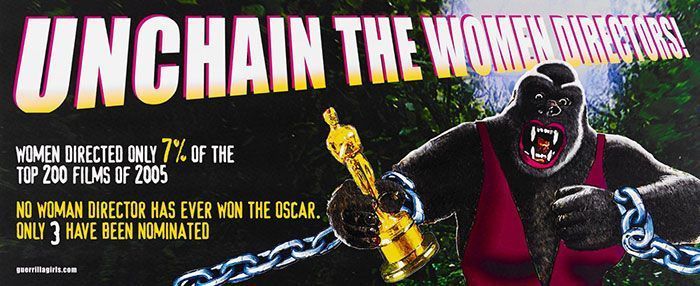
Unchain The Women Directors
"Queen Kong," as the Guerrilla Girls dubbed her, appeared as a Hollywood billboard just in time for Oscar month. Mimicking the eye-catching look of an old poster and in an obvious allusion to the classic King Kong film, it features a swimsuit-clad gorilla grasping an Oscar statue. "UNCHAIN THE WOMEN DIRECTORS" challenges the film industry. "WOMEN DIRECTED ONLY 7% OF THE TOP 200 FILMS OF 2005," smaller text underneath reveals, and "NO WOMAN DIRECTOR HAS EVER WON THE OSCAR. ONLY 3 HAVE BEEN NOMINATED." Emphasizing statistics (enlarging and highlighting the 7% in gold and the number 3 in white) that are actually quite depressing, it uses the film industry's own visual language to critique it. This is also a reference to themselves, as well as the famous film. Now associated with the gorilla image every bit as much as the film is, the Guerrilla Girls have come full circle.
Poster - Walker Art Center, Minneapolis

Even Michele Bachmann Believes “We All Have The Same Civil Rights.”
As the Guerrilla Girls gained fame, they were able to show their work in an array of prominent, meaningful public spaces and reach outside the art world. Displayed as a billboard in Minneapolis, Minnesota, this poster advocates for same sex marriage featuring one of its staunchest opponents, conservative politician Michele Bachmann. Bachmann's advocacy for a constitutional ban on gay marriage was one of the central tenets of her campaign for presidency in 2012. Here her statement "We all have the same civil rights" is taken out of context, and printed large above the words "Vote No on the marriage discrimination amendment", an amendment Bachmann had supported. The hot pink title phrase, human rights symbol over Bachmann's lips, and "NO" in the text, highlight the hypocrisy of her position. The use of this color also alludes to the Nazi use of pink, (under the Nazi regime, persons identified as homosexuals were forced to wear a pink triangle).
Poster - Dallas Museum of Art, Texas
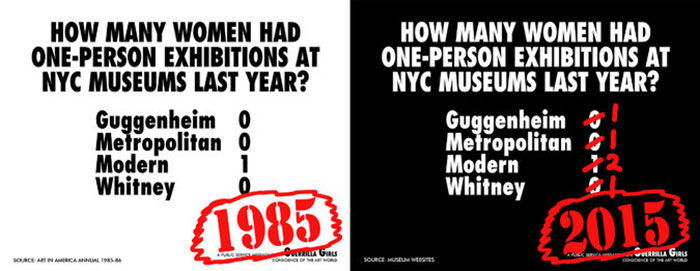
How Many Women Had One-person Exhibitions At NYC Museums Last Year?
In a simple black/white/red textual layout, this poster juxtaposes the number of women who had one-person exhibitions at New York City Museums in 1985 and 2015. Juxtaposed side by side, as in a slide lecture, the images and text are similar enough that one has to look twice. What stands out are the enlarged dates, drawing attention to the amount of time that has passed, and how little these numbers have moved. Not as much progress as one might expect. This poster encapsulates the significance of the Guerrilla Girls' role in the history of art over nearly half a century, and how far there still is to go before gender equity is reached in the art world.
Sticker
Origins of the Group
Two main events inspired the formation of the Guerrilla Girls. One was the publication of the influential feminist essay "Why have there been no great women artists?" in 1971 by art historian Linda Nochlin. As the title suggests, Nochlin accepts that throughout history, women have failed to achieve greatness on a par with the Michelangelos and Picassos of the art world. Nochlin blames the art world, eschewing the oft-repeated explanation that women must be somehow biologically or intellectually inferior. In a deeply segregated system with long-entrenched institutional biases, she argues, women had never had the opportunity to compete on a level playing field with their male peers. Laying the blame squarely on the art world, Nochlin writes: "The fault lies not in our stars, our hormones, our menstrual cycles, but in our institutions and our education."
The second event occurred in 1984, when only 13 out of 169 contemporary artists invited to display work at the Museum of Modern Art's International Survey of Recent Painting and Sculpture were women. The Women's Caucus organized a protest in front of MoMA. Along with others, the Guerrilla Girls stood outside the exhibition with signs, and all were ignored. "We went to this demonstration with the usual: placards, picket signs, things like that and we saw it immediately: nobody cares. Not one person outside of MoMA cared about us, everyone walked right in and nobody wanted to hear about women, about feminism". As if to underscore that the art world gave no thought to women artists at all, the exhibition's curator Kynaston McShine remarked offhandedly that "any artist who wasn't in the show should rethink his career". According to the Guerrilla girls, "That was the 'aha!' moment: it was so obvious that there had to be a better way, a more media savvy, more contemporary way to get through to people."
Guerrillas vs Gorillas
The "more media savvy, more contemporary way" developed by the group included the fortuitous misspelling of "guerrilla" by one of the group members. That gave them the idea to adopt gorilla masks as their official disguise. In 1985 they began pasting posters or stickers in visible places near art galleries and museums in New York City.
Their first posters, which contained no imagery, combined a statement directed toward the underrepresentation of women in the art world with bullet points supporting evidence of gender discrimination below, with specific mention of galleries, exhibitions, and art valuations. Inspired by the work of Jenny Holzer and Barbara Kruger, these early works relied on text and graphic design, using advertising techniques to make pointed social commentary. The group often targeted specific galleries, museums, and individuals.
Early Work
The Guerrilla Girls wore gorilla masks to maintain anonymity and "to keep the focus on the issues rather than our personalities." Their true identities remain unknown. Each member took on the name of a deceased artist or other creative luminary. Frida Kahlo, Rosalba Carriera, Lee Krasner, Gertrude Stein, Zora Neale Hurston, and other names connected them to their predecessors, women who in the 1980s were still absent from most history textbooks, and whose work was even sometimes misattributed to male artists.
While given lip service, feminism and diversity were often met with indifference in the art world of the 1980s. To combat this indifference and get a reaction, the Guerrilla Girls involved humor, irony, visible outrageousness, advertising design, and strategic targeting of individuals and institutions. Influenced by the Feminist movement of the 1970s, the Guerrilla Girls adopted activist strategies. Not afraid to seem pushy and obnoxious, the Guerrilla Girls persisted in waging war on what they felt was an unfair system. While best-known for their poster campaigns, the Guerrilla Girls also conducted public actions, exhibitions, panels, and lectures that targeted specific institutions and individuals that held gatekeeper status. One 1985 poster stated, "On Oct. 17 the Palladium Will Apologize to Women Artists" (the Palladium, a famous dance club in New York that showcased work by contemporary artists, had only ever shown work by men). The club responded favorably, working with the Guerrilla Girls to issue an open call to women artists, and staging a week-long exhibition of work by women that would, as the announcement put it, "forever put to rest the following notions: (1) Biology is destiny, (2) There are no great women artists, (3) It's the men who are emotional and intuitive, and (4) Only men can show at the Palladium." A group of members of the Palladium resigned in protest over the all-female show, explaining "We couldn't beat the system and join it at the same time. The group was moving in the wrong direction".
What is difficult to stress, in retrospect, was how controversial the Guerrilla Girls' tactics were at a moment when the art world was less open to the overt mixture between politics and art. The range of institutional and individual responses to their actions was mixed. Even in the most liberal circles, some art world insiders who considered themselves feminist resented the idea of filling quotas. Nonetheless, institutions began to take notice. In 1986 Cooper Union hosted two panels organized by the Guerrilla Girls: "Hidden Agender: An Evening with Critics" and "Passing the Bucks: An Evening with Art Dealers". These panels invited critics and dealers (respectively) to share their thoughts on the gender gap in art, and how to close it.
In 1987, The Clocktower, an independent exhibition space, invited the Guerrilla Girls to organize an exhibition of work protesting the Whitney Museum's Biennial of contemporary American art, "Guerrilla Girls Review the Whitney". In 1989, hoping to reach a larger audience, the group created a poster, Do women have to be naked to get Into the Met. Museum?. It ran as an ad on public buses. The prominent placement and memorable simplicity of the image and caption, probably still their best-known work, had the desired effect, lifting them and an awareness of the issue into mainstream public consciousness.
Mature Work
Lifted into the limelight in the late 1980s, the Guerrilla Girls began to develop something of a cult following. They continued to employ advertising designs, startling images, selected facts, and targeting a specific audience in posters, stickers, and billboards. They appeared at panels, lectures, exhibitions, and performances at increasingly mainstream art institutions and universities. In 1988, they issued what is probably their second most famous poster entitled sarcastically "The Advantages of Being a Woman in the Art World", demonstrating with an arresting image and statistics that exclusionary institutional practices were alive and well in the contemporary art world.
Perhaps because, as the feminist art historian Bell Hooks notes, "the work of the Guerrilla Girls represents a most powerful political union between theory and practice," the group's artistic strategies and techniques have remained remarkably consistent. What expanded was the range and scope of their focus. Initially concerned with the inequities of the art world for women, the Guerrilla Girls responded to criticisms of being primarily concerned with "white feminism". In the 1990s they extended their range to the inequities of racism, and their geographic reach outside New York. They began to critique the major art institutions, art collectors, and critics in the rest of the US and then Europe.
In 1998 they published the best-selling Guerrilla Girl's Bedside Companion to the History of Western Art (1998), which is a comic book in their characteristic style telling the history of art using only women. It shows how some of women's best works were attributed to men, left out of mainstream art history books, and devalued in the art market.
Inspired by Nochlin's "Why Have There Been No Great Women Artists" (1971), Guerrilla Girl's Bedside Companion to the History of Western Art poses the following, modified version of the question: "Why haven't more women been considered great artists in the history of Western art?" The book, a scathing historical analysis, answers the question by pointing out how major museums and art institutions continue to dismiss and undervalue the work of women.
The group's awareness of film, evident in their adoption of the gorilla mask (a reference to King Kong) took on a life of its own in works that addressed the sexism of the film industry. UNCHAIN THE WOMEN DIRECTORS (2006), a billboard displayed in Hollywood during Oscar month, was made in protest of the underrepresentation of female directors.
Continuing practice
Today, Frida Kahlo and Kathe Kollwitz are the only founding members who remain active in the group. A reasonable estimate is that 100 women have participated in the group over the years. Ideologically, however, the group espouses a philosophy that includes all women as potential members. When asked how many members they had in 1995 they replied:"We don't have any idea. We secretly suspect that all women are born Guerrilla Girls. It's just a question of helping them discover it. For sure, thousands; probably, hundreds of thousands; maybe, millions."
A growing presence in the art world and beyond, the Guerrilla Girls have reached an ever-wider audience. The 2005 Venice Biennale included six posters by the Guerrilla girls critiquing gender discrimination in the art world, the film industry, and Bush administration policies. The Guerrilla Girls' participation in the mainstream art world and beyond reflects their success in raising awareness of racism and sexism across the board.
Since 2000, incorporated offshoots of the Guerrilla Girls have emerged, making the group seem more like a movement than an artists' collective. Among them are Guerrilla Girls, Inc. (established by two of the movement's founders), GuerillaGirlsBroadBand, Inc., and Guerrilla Girls On Tour, Inc. Whether within these organizations, or otherwise, the Guerrilla Girls continue to track the percentages of women and artists of color included in exhibitions, galleries, and art journalism, and underscore any double standards that persist.
Legacy
In the 1980s, many women artists felt their careers were precarious enough that they could not succeed as artists and fight the feminist battle too. The Guerrilla Girls proved them wrong. They succeeded in transforming the relationship between art and politics. They made activism seem not only acceptable, but vital to full participation in the art world. Critical reviews, still quite new when Guerrilla Girls arrived on the scene, are now fairly standard practice. They influenced a generation of critics and curators to be more inclusive of women and minorities.
Their combination of humor, outrageous visuals, and statistics influenced the work of individual feminist artists like Micol Hebron and Coco Fusco. In her Gallery Tally Project, Hebron counts the representation of women in international galleries. Fusco has written of a Guerrilla Girls exhibition "It was my first encounter with a full-on feminist art intervention, and I was tickled and inspired. This was an activist approach that I could connect with, as it spoke truth to power playfully, with wit and style" and credited the group with teaching her "crucial lessons that have informed the way I think about art, the way I understand feminism and the way I make art today." Their mockery of the shrill feminist stereotype (a category into which any activist who spoke her mind might get put) inspired the curatorial project of Nicole Eisenman and A.L. Stein, Ridykeulous, focusing on stereotypical representations of queer artists.
The Guerrilla Girls also paved the way for other outspoken feminist groups outside the art world. Pussy Riot, a feminist punk rock collective, employs "impudence, politically loaded lyrics, the importance of feminist discourse and a non-standard female image" to address LGBTQ rights, feminism, and to express opposition to Putin's government in Russia.
Influences and Connections

-
![Feminist Art]() Feminist Art
Feminist Art -
![Conceptual Art]() Conceptual Art
Conceptual Art ![Activist Art]() Activist Art
Activist Art
Useful Resources on The Guerrilla Girls
- Bitches, Bimbos, and Ballbreakers: The Guerrilla Girls' Illustrated Guide to Female StereotypesBy Guerrilla Girls
- Guerrilla Girls' Art Museum Activity BookBy Guerrilla Girls
- The Guerrilla Girls' Bedside Companion to the History of Western ArtOur PickBy Guerrilla Girls
 Ask The Art Story AI
Ask The Art Story AI














